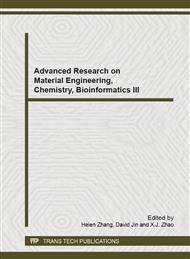p.115
p.119
p.122
p.126
p.130
p.135
p.139
p.143
p.147
Investigation of Y1-xCaxBaCo2O5+δ Cathodes for Intermediate-Temperature Solid Oxide Fuel Cells
Abstract:
Double-perovskites Y1-xCaxBaCo2O5+δ (YCBC,x = 0.1-0.5) were synthesized with a auto ignition process and were assessed as cathode materials for intermediate-temperature solid oxide fuel cells (IT-SOFCx) based on Sm0.2Ce0.8O1.9 (SDC) electrolyte. X-ray diffraction confirms that there are some undesired peaks in YCBC0.1 and YCBC0.5, while the YCBC (x = 0.2-0.4) retains single phase with tetragonal structure. The YCBC materials exhibit chemical compatibility with SDC electrolyte up to a temperature of 1100°C. The conductivity of the samples decreases with increasing Ca content, and the maximum conductivity of YCBC is 506 Scm-1 for x = 0.2 sample. The increased doping of Ca deteriorates the area-specific resistances of YCBC (x = 0.2-0.4) cathodes. The Rp values of YCBC cathodes at x = 0.2,0.3 and 0.4 on the SDC electrolyte are 0.26, 0.53 and 1.19Ωcm2 at 650°C, respectively. This study suggests that YCBC0.2 can be potential candidates for utilization as IT-SOFCs cathode.
Info:
Periodical:
Pages:
130-134
Citation:
Online since:
October 2013
Authors:
Price:
Сopyright:
© 2014 Trans Tech Publications Ltd. All Rights Reserved
Share:
Citation:


